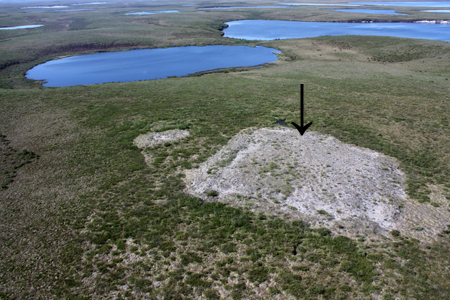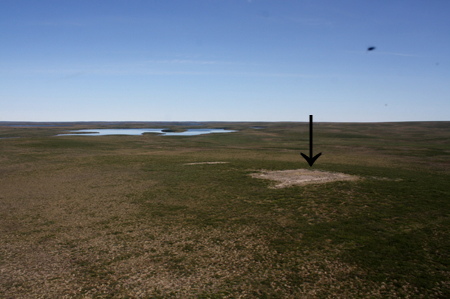|
Examples of drilling mud sumps. Note:
These are sumps and not the thaw slumps
depicted further down. Check difference between sump and slump. Sumps
marked by ↓ . |
 |
 |
 |
|
Drilling mud sump with significant ponding.
This large drilling sump exhibits ponding both on the surface and
perimeter. Image courtesy of Joshua Thienpont (Brock University). |
Drilling sump in close proximity to a lake.
The drilling sump is located upslope of the small lake, and any
materials leaching from the sump could potentially enter the lake.
Image courtesy of Joshua Thienpont (Brock University). |
Large drilling sump near Mackenzie Delta lake.
This large sump is perched above and close to the edge of a small lake.
The gravel road created during drilling is still visible. Image courtesy
of Joshua Thienpont (Brock University). |
 |
 |
 |
|
Drilling mud sump near a small lake.
Image courtesy of Steve Kokelj (Government of the Northwest
Territories). |
Drilling mud sump in the Mackenzie Delta uplands showing surface
ponding.
Image courtesy of Steve Kokelj (Government of the Northwest
Territories). |
Drilling mud sump.
The large, raised cap of the drilling sump is noticeable because of its
altered vegetation and ponding around the perimeter. Image courtesy of
Joshua Thienpont (Brock University). |
 |
 |
 |
|
Drilling mud sump exhibiting significant surface
and perimeter ponding.
Image courtesy of Michael Pisaric (Brock University). |
Drilling mud sump exhibiting significant surface
and perimeter ponding.
Image courtesy of Michael Pisaric (Brock University). |
Drilling mud sump with an un-vegetated gravel cap.
Image courtesy of Michael Pisaric (Brock University). |
 |
 |
 |
|
Drilling mud sump with a small lake in the
background.
Image courtesy of Michael Pisaric (Brock University). |
Drilling mud sump with an un-vegetated gravel cap.
Image courtesy of Michael Pisaric (Brock University). |
Drilling mud sump with an un-vegetated gravel cap.
Image courtesy of Michael Pisaric (Brock University). |
